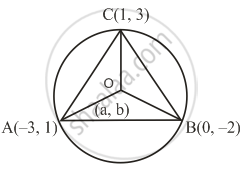Advertisements
Advertisements
प्रश्न
Find the coordinates of the circumcentre of a triangle whose vertices are (–3, 1), (0, –2) and (1, 3).
उत्तर

Let A(−3, 1), B(0, −2), C(1, 3) and the circumference O(a, b).
The distance of point O will be equal from A, B and C.
OA = OC ...(Radii of the same circle)
∴ `sqrt([a - (-3)]^2 + (b - 1)^2) = sqrt((a - 1)^2 + (b - 3)^2)` ...(Distance formula)
Squaring both the sides,
`(a + 3)^2 + (b - 1)^2 = (a - 1)^2 + (b - 3)^2`
`∴ cancela^2 + 6a +cancel9 + cancelb^2 − 2b + cancel1 = cancela^2 − 2a + cancel1 + cancelb^2 − 6b + cancel9`
∴ 6a − 2b = −2a − 6b
∴ 6a + 2a = − 6b + 2b
∴ 8a = −4b
∴ 8a + 4b = 0
∴ 4(2a + b) = 0
∴ 2a + b = 0 ....(I)
OB = OC ...(Radii of the same circle)
∴ `sqrt((a - 0)^2 + [b - (- 2)]^2) = sqrt((a - 1)^2 + (b - 3)^2)` ...(Distance formula)
Squaring both the sides,
`(a - 0)^2 + (b + 2)^2 = (a - 1)^2 + (b - 3)^2`
`∴ cancela^2 + cancelb^2 + 4b + 4 = cancela^2 − 2a + 1 + cancelb^2 − 6b + 9`
∴ 4b + 4 = − 2a − 6b + 10
∴ 4b + 2a + 6b = 10 - 4
∴ 2a + 10b = 6 ...(II)
Subtracting I from II, we get,
\[\begin{array}{1}
\phantom{\texttt{}}\texttt{2a + b = 0}\\ \phantom{\texttt{}}\texttt{- 2a + 10b = 6}\\ \hline\phantom{\texttt{}}\texttt{(-) (-) (-)}\\ \hline \end{array}\]
∴ - 9b = - 6
∴ b = `(-6)/(-9)`
∴ b = `2/3`
Substituting b = `2/3` in equation I, we get,
∴ 2a + b = 0
∴ 2a + `2/3` = 0
∴ 2a = `-2/3`
∴ a = `-2/3 xx 1/2`
∴ a = `(-1)/3`
Coordinates of the circumcentre are `((-1)/3, 2/3)`.
संबंधित प्रश्न
Let ABCD be a square of side 2a. Find the coordinates of the vertices of this square when A coincides with the origin and AB and AD are along OX and OY respectively.
Find the third vertex of a triangle, if two of its vertices are at (−3, 1) and (0, −2) and the centroid is at the origin.
If A and B are (1, 4) and (5, 2) respectively, find the coordinates of P when AP/BP = 3/4.
The line joining the points (2, 1) and (5, -8) is trisected at the points P and Q. If point P lies on the line 2x - y + k = 0. Find the value of k.
Find the points on the x-axis, each of which is at a distance of 10 units from the point A(11, –8).
Show hat A(1,2), B(4,3),C(6,6) and D(3,5) are the vertices of a parallelogram. Show that ABCD is not rectangle.
Two points having same abscissae but different ordinate lie on
The perpendicular distance of the point P (4, 3) from x-axis is
Find the value of a for which the area of the triangle formed by the points A(a, 2a), B(−2, 6) and C(3, 1) is 10 square units.
Find the value of a so that the point (3, a) lies on the line represented by 2x − 3y + 5 = 0
Find the area of triangle with vertices ( a, b+c) , (b, c+a) and (c, a+b).
The perimeter of the triangle formed by the points (0, 0), (0, 1) and (0, 1) is
If the centroid of a triangle is (1, 4) and two of its vertices are (4, −3) and (−9, 7), then the area of the triangle is
The line segment joining points (−3, −4), and (1, −2) is divided by y-axis in the ratio.
The point on the x-axis which is equidistant from points (−1, 0) and (5, 0) is
If P(2, 4), Q(0, 3), R(3, 6) and S(5, y) are the vertices of a parallelogram PQRS, then the value of y is
If A(x, 2), B(−3, −4) and C(7, −5) are collinear, then the value of x is
Find the coordinates of the point whose ordinate is – 4 and which lies on y-axis.
Find the coordinates of the point whose abscissa is 5 and which lies on x-axis.
Co-ordinates of origin are ______.
